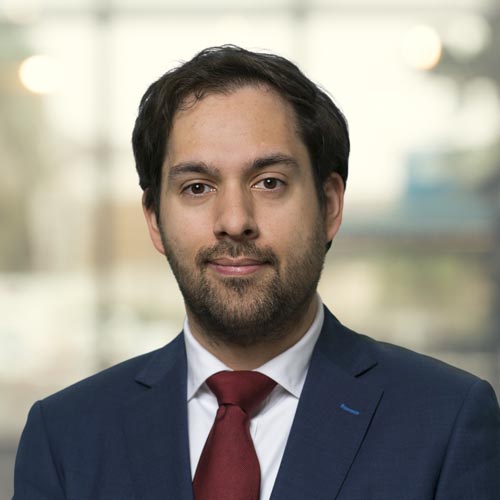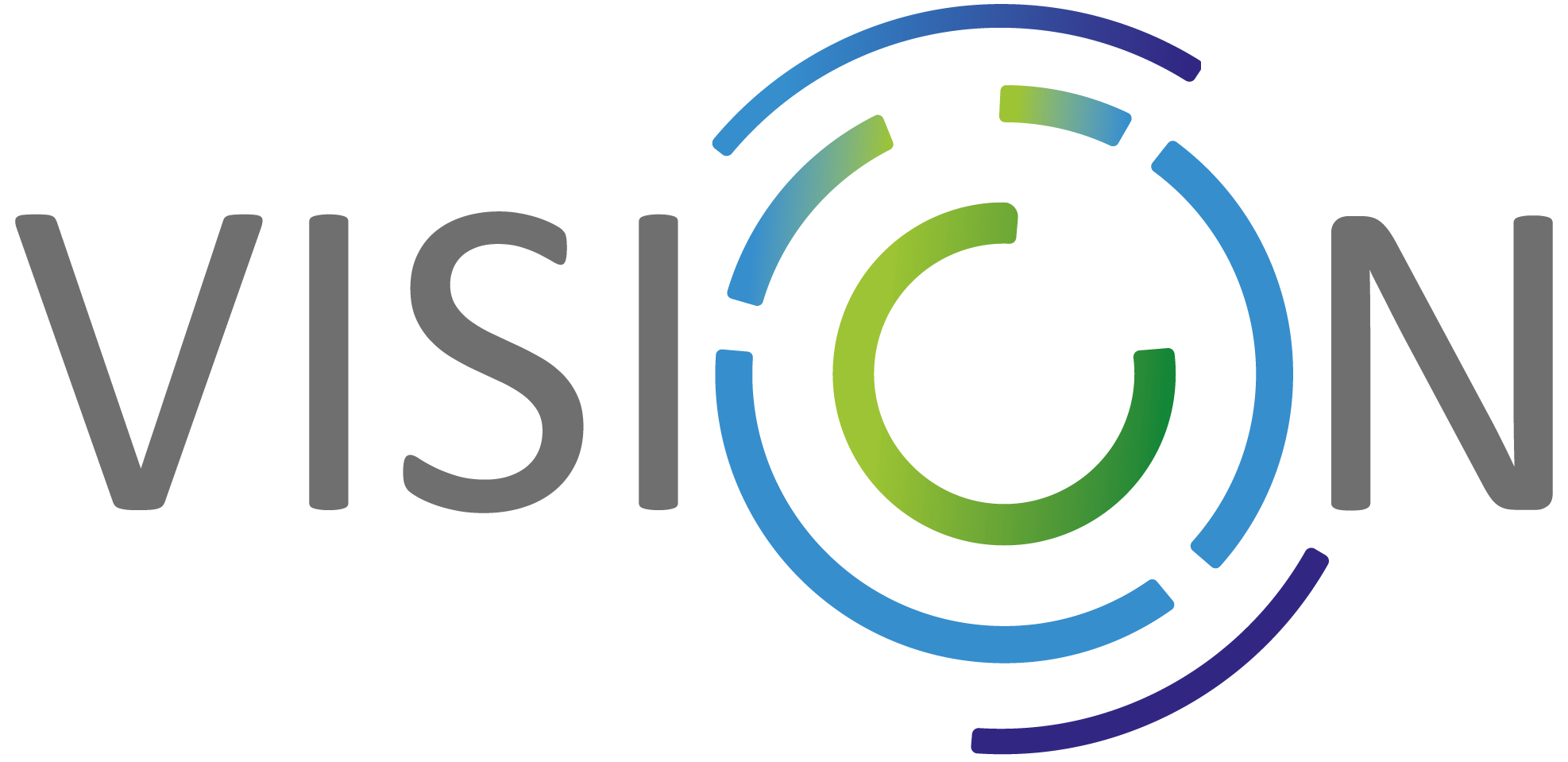Ecosystem Mapping: Towards a Mapping of the AI-Data-Robotics Ecosystem
This ecosystem mapping is intended as a tool that gives an overview of the research, development and innovation (R&D&I) activities on AI-related themes across Europe and associated countries (e.g. Israel, Türkiye), and as a tool for finding organisations across Europe and beyond that work on specific AI themes, on the intersection with specific application domains.
In brief
- Aim: Provide overview of organisations working on AI-related topics, and the application areas in which they are active
- Scope: 9 Networks of Excellence
- Goal: Develop a prototype
- Method: Use survey to collect data, agree AI categories and application areas
Intended value
- Navigating the European R&I ecosystem
- Identifying and visualizing research excellence and impact
- Showing affiliation and more in-depth information
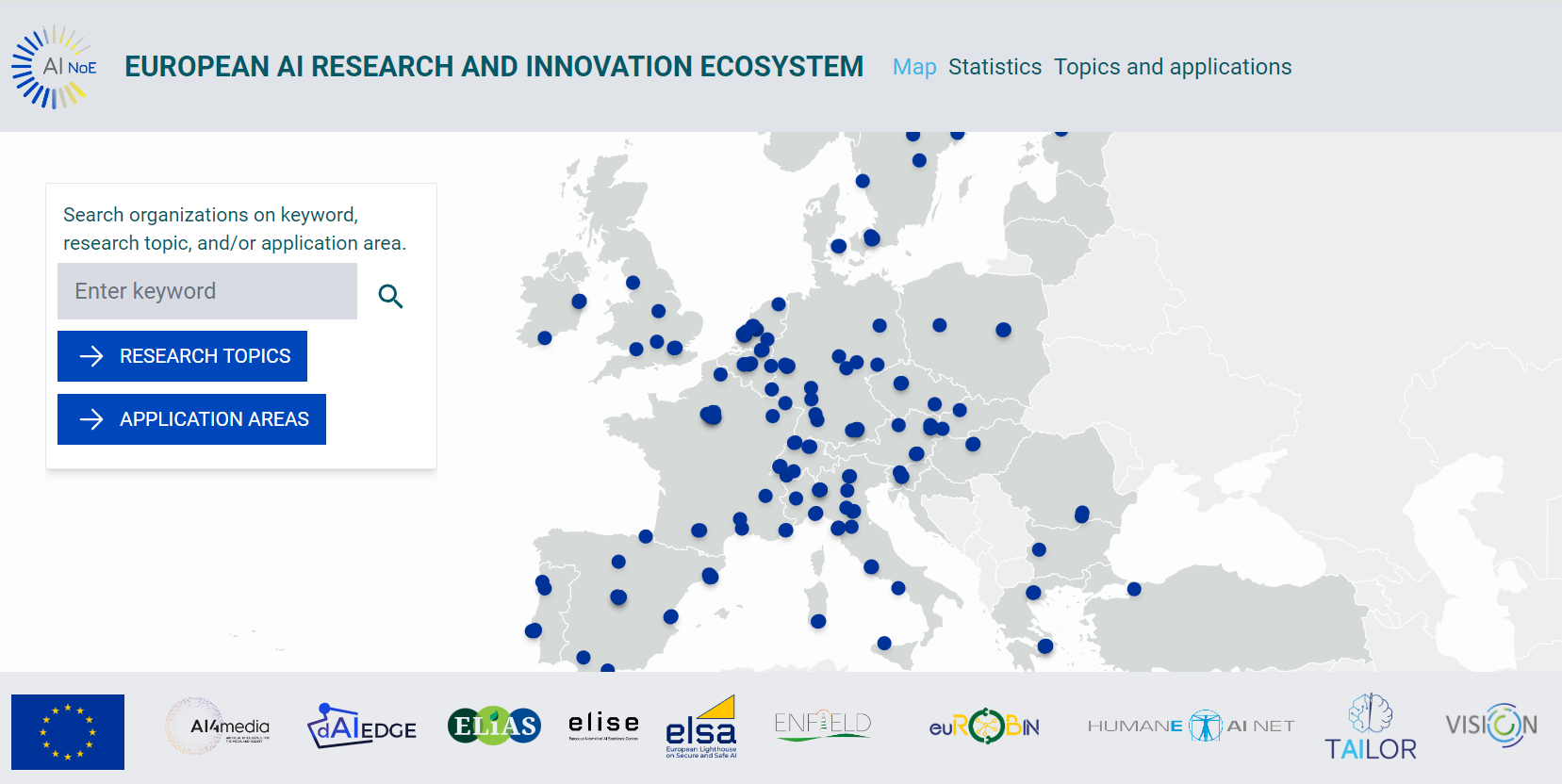
JTG Initiative
In May 2024, a This Joint Topic Group on ‘Ecosystem Mapping & Information Repository’ (EMIR) of the AI-Data-Robotics association (Adra) was initiated by TNO, UCC and University of Twente as an open forum for the further development of the mapping, with the mission to maximize the effectiveness of the AI, Data and Robotics community by supporting the development and maintenance of an ecosystem mapping and information services that are of value to the ADR research & innovation community.
Mission of JTG: Maximize the effectiveness of the AI, Data and Robotics (ADR) community by supporting the development and maintenance of an ecosystem mapping and information services that are of value to the ADR research & innovation community.
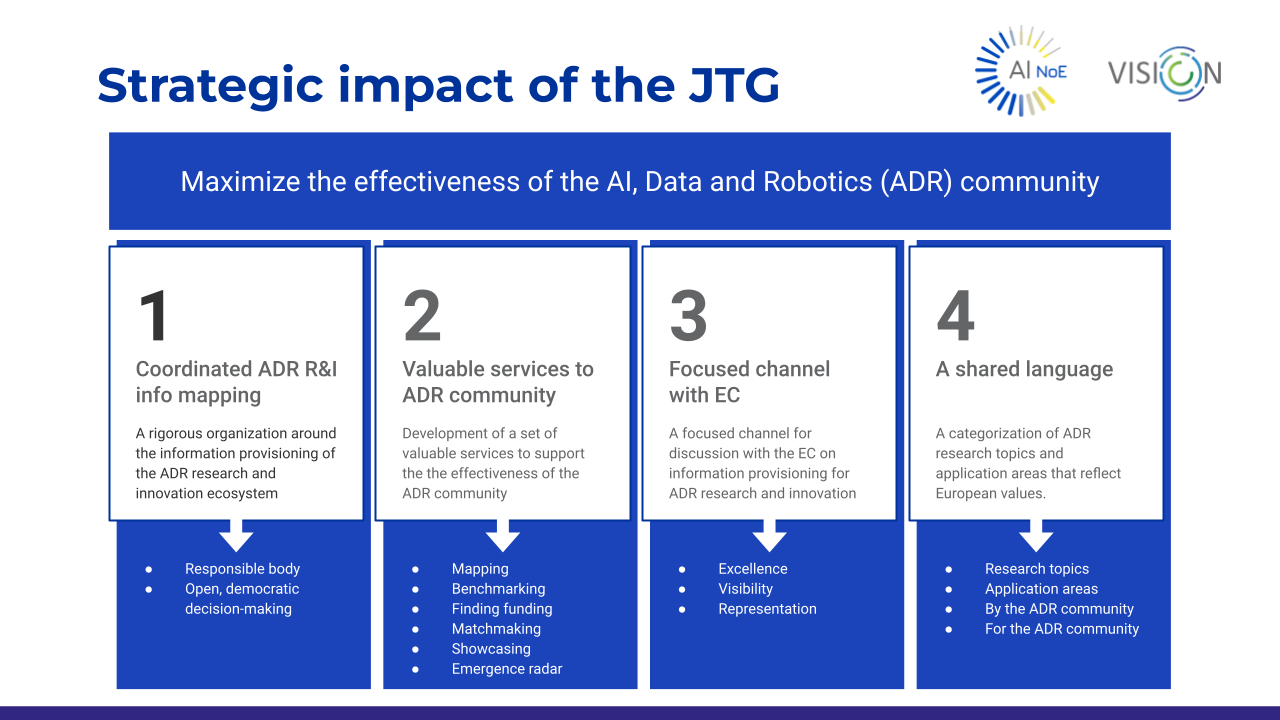
Why an AI ecosystem mapping?
Research, development and innovation in the field of AI takes place all across the European continent and beyond. However, an integrated overview of these activities – and especially the expertise – is lacking. Therefore, the EC has tasked VISION and several Networks of Excellence (AI4Media, ELISE, HumanE-AI-Net, TAILOR, ELSA and euROBIN) to start mapping the capabilities and competencies in the current AI ecosystem in Europe.
The objective of this task was to lead the process and develop a first prototype of a mapping of the AI R&I ecosystem in the form of an interactive website, based on the Networks of Excellence (NoEs), and we have produced a first version which was launched at the AI-Data-Robotics Forum (ADRF) in November 2023.
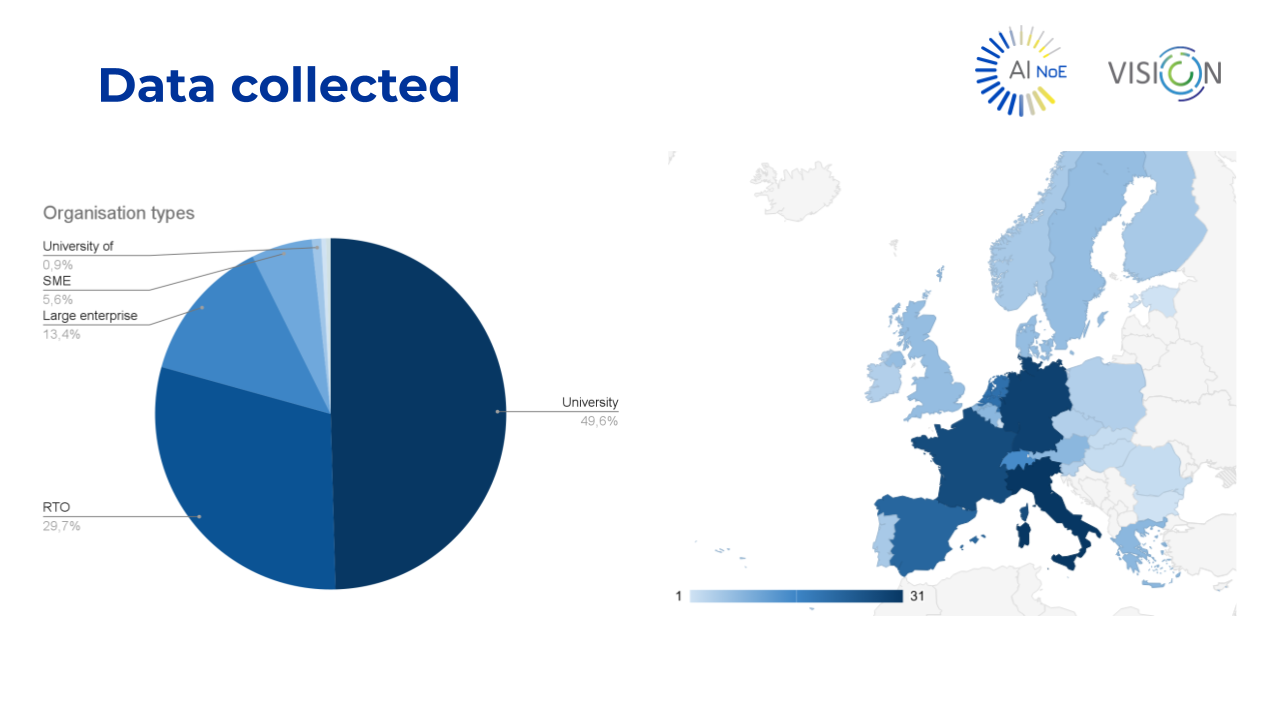
Process
Together with representatives of each NoE, and advised by the EC, we developed a shared taxonomy of research topics and application areas, collected the data and developed a first version of an interactive website.
VISION set up a working group with representatives from AI4Media, ELISE, HumanE-AI-Net, TAILOR, ELSA and euROBIN. With this working group, and advised by the EC, we developed a shared categorisation of research topics and application areas, developed a survey, and constructed a list of respondents based on the consortium members.
Key decision-making moments were i) the 2nd community workshop (Oct 2022) where we decided on pursuing this shared endeavour, ii) the 3rd community workshop (June 2023) where we updated the NoEs on the progress, discussed the difficulties in coming to a shared taxonomy and during which a process agreement was made across the NoEs, and iii) the EC workshop (4 July 2023), where we presented the plan to realise the ecosystem mapping in the coming months. During this time, the focus was on agreeing on the process and a goal with all involved parties and organising the taxonomy and survey, which ensured a quick execution afterwards.
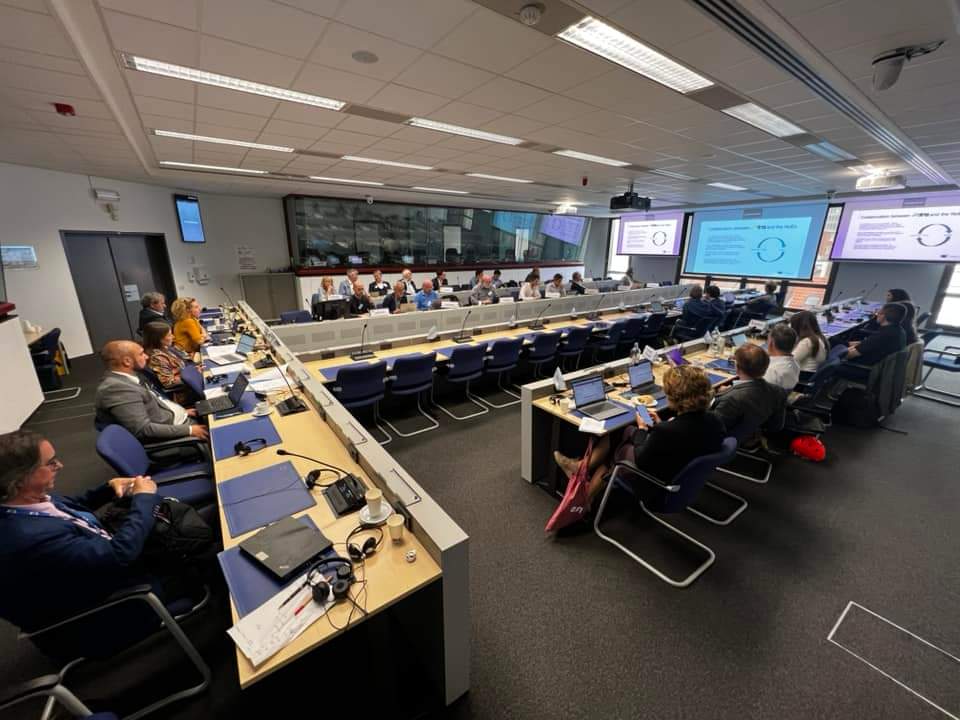
About the tool
This AI ecosystem mapping is intended as a tool that gives an overview of the research, development and innovation (R&D&I) activities on AI-related themes across Europe and associated countries (e.g. Israel, Türkiye), and as a tool for finding organisations across Europe and beyond that work on specific AI themes, on the intersection with specific application domains.
Research topics and application areas
For the mapping it was necessary to create a shared language for the Networks of Excellence (which are focused on research). It was agreed upon to start from an established set of academic keywords, in our case the AAAI-23 topics. Together with all the Networks of Excellence, we decided on a process which resulted in the current topics list (see the table). The process and principles we agreed upon was:
- Start with the 12 research areas and 12 application areas of that we started out with, and combine with the AAAI-23 conference topics.
- Changes at the top level were made only if it is justified (e.g. a more representative title). At the subtopics level, the NoEs were able to add as many topics as they want.
- Maintain a maximum of 12 high level categories to keep it comprehensive
- The high-level topics are alphabetically sorted, the taxonomy should not imply any primacy.
All changes were reviewed by the working committee. Agreeing on a shared taxonomy was an important step in the process of coming together, and we were well supported by the EC along the way. Our next step is to ensure a mechanism to maintain and update the taxonomy once it’s up and running. That way, over time, it will be adapted based on bottom-up changes and become more representative of the EU research.
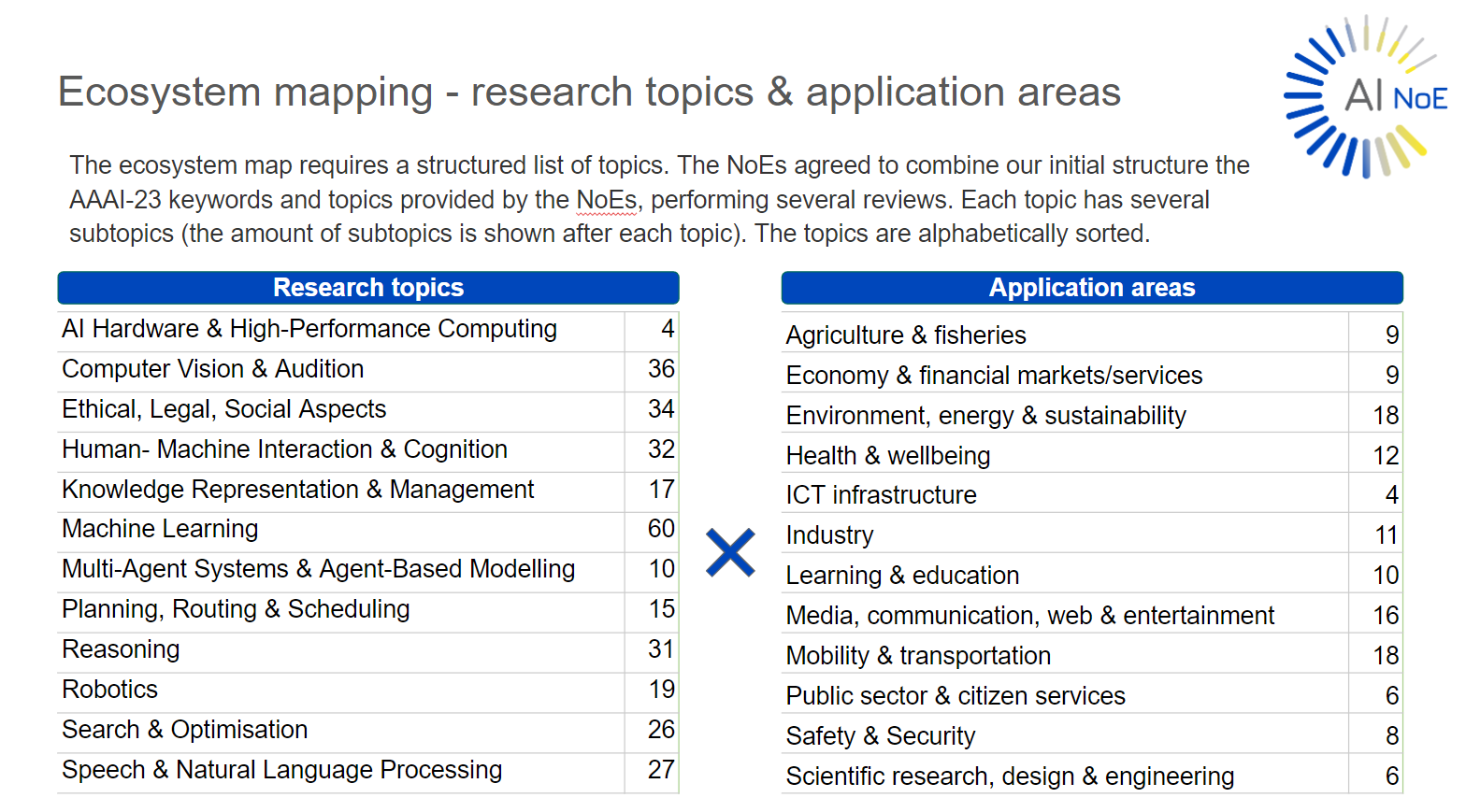
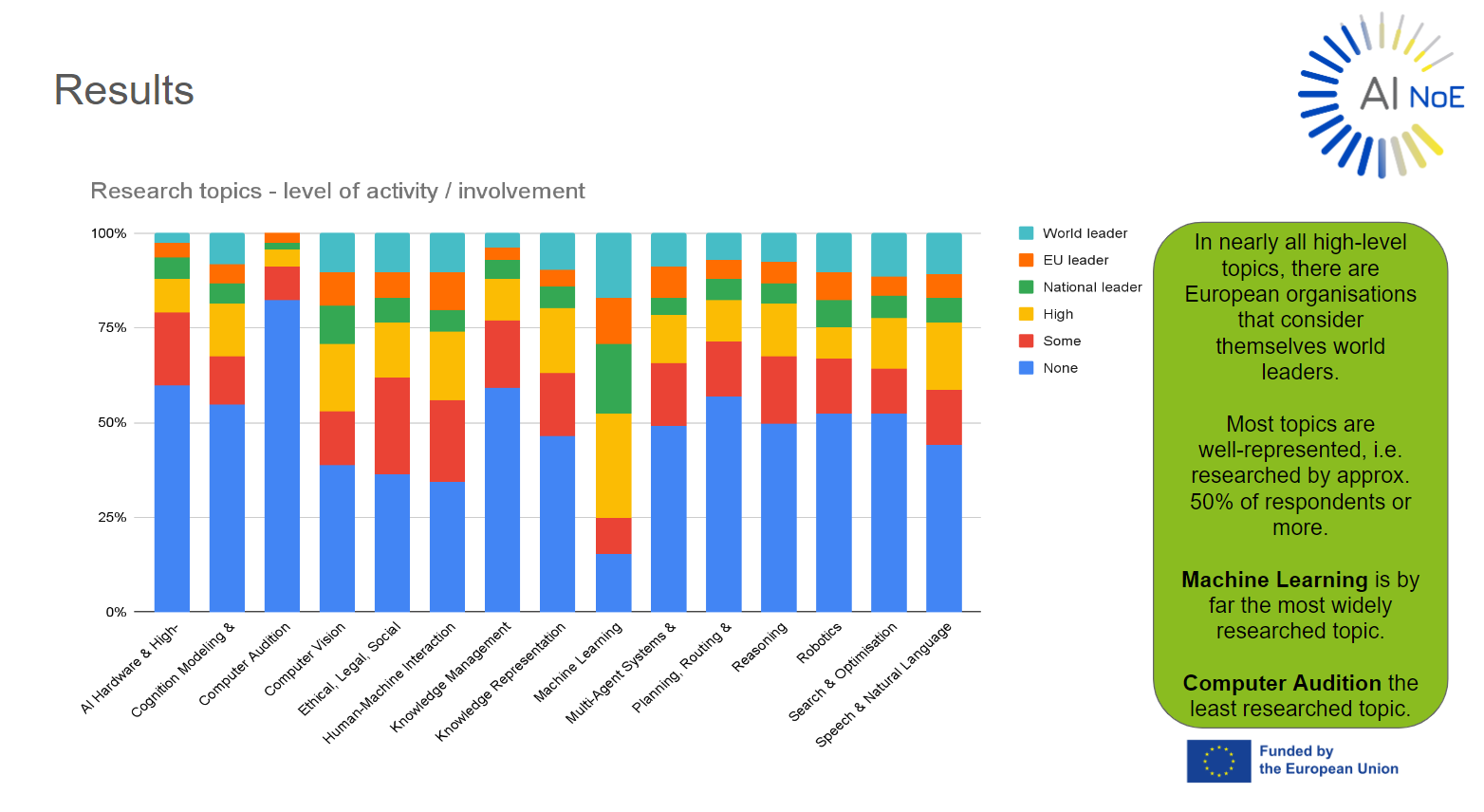
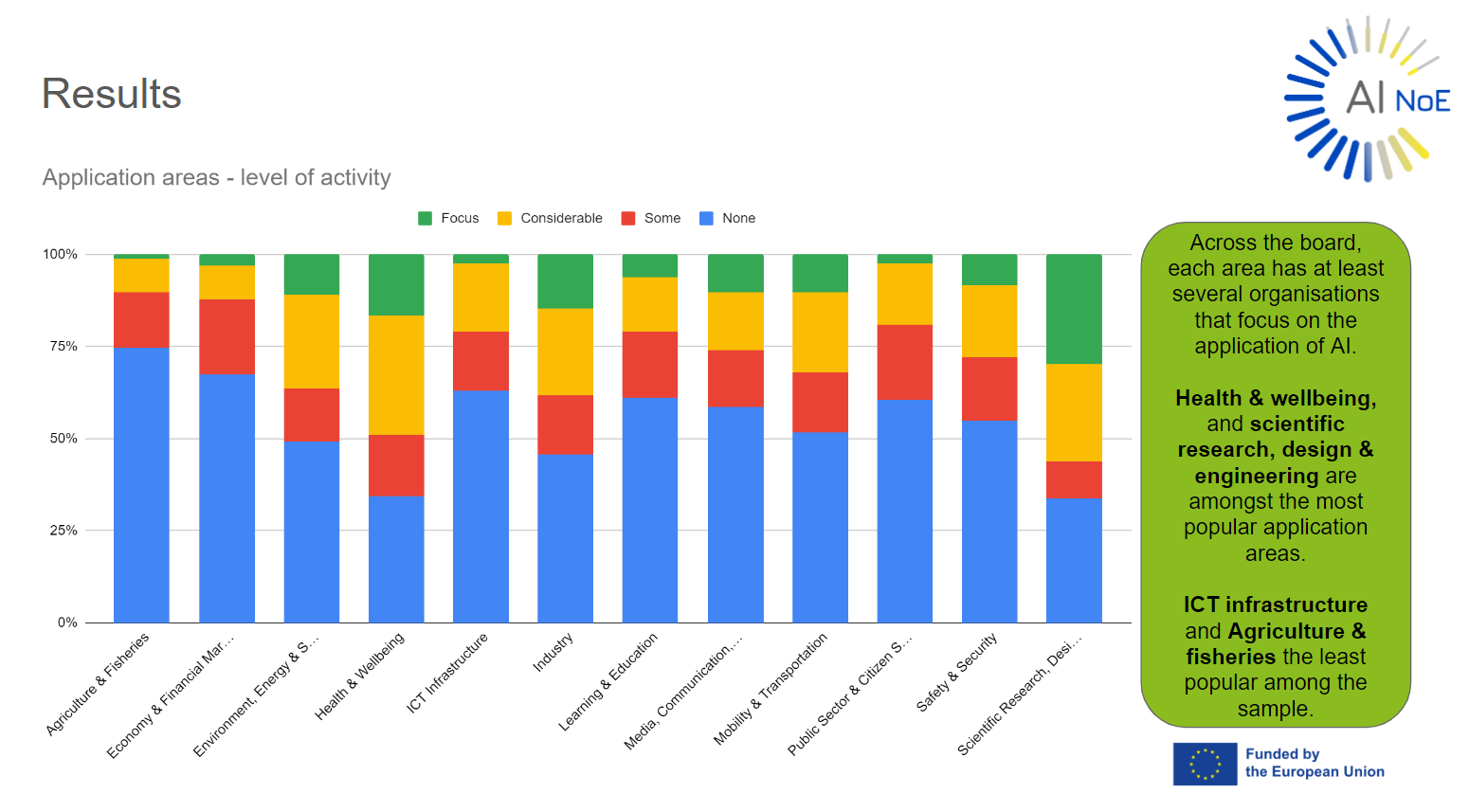
About the data
- Data collected: Organisation details (name, url, contact, location, type of org, type of activity, FTE, NoE membership), research topics activity levels per high-level topic, research subtopics, application area activity levels per high-level topic, application area subtopics
- Scope: There are many organizations active in R&D&I (see R&I Organisation profiles (europa.eu)). In consultation with the European Commission, the scope of this mapping activity was all partner organisations within the AI Networks of Excellence (NoE): AI4Media, ELISE, ELSA, euROBIN, euROBIN, HumanE-AI-Net, TAILOR. In total, 165 organisations responded to the survey (65% of all partner organisations) and the dataset keeps growing.
- Data quality: Self-reported activity levels are used as an proxy indicator for activity levels and thus may be overestimated. Information cannot automatically be verified, and the indicators are not intended for measuring or evaluating organisations’ performance or reputation.
- Data collection and cleaning: The data has been collected via a survey which was disseminated by NoE representatives. The main principle for data cleaning was to keep as much of the original input as possible, since they are decisions on how the organisations wish to represent themselves. The data was cleaned insofar as this contributed to consistency, legibility, correctness and integration with the tool.
Cleaning steps:
- Removed spelling errors and casing (AI llab –> AI lab, TORINO –> Torino)
- Corrected wrong input (e.g. an email address filled in under the full name)
- Enforced consistency of organisation names, in particular for multiple submissions (INRIA –> Inria)
- Consistent and working URLs (all have https://, and are working)
- Simplified organisation types uppercase, added GPS coordinates for the mapping
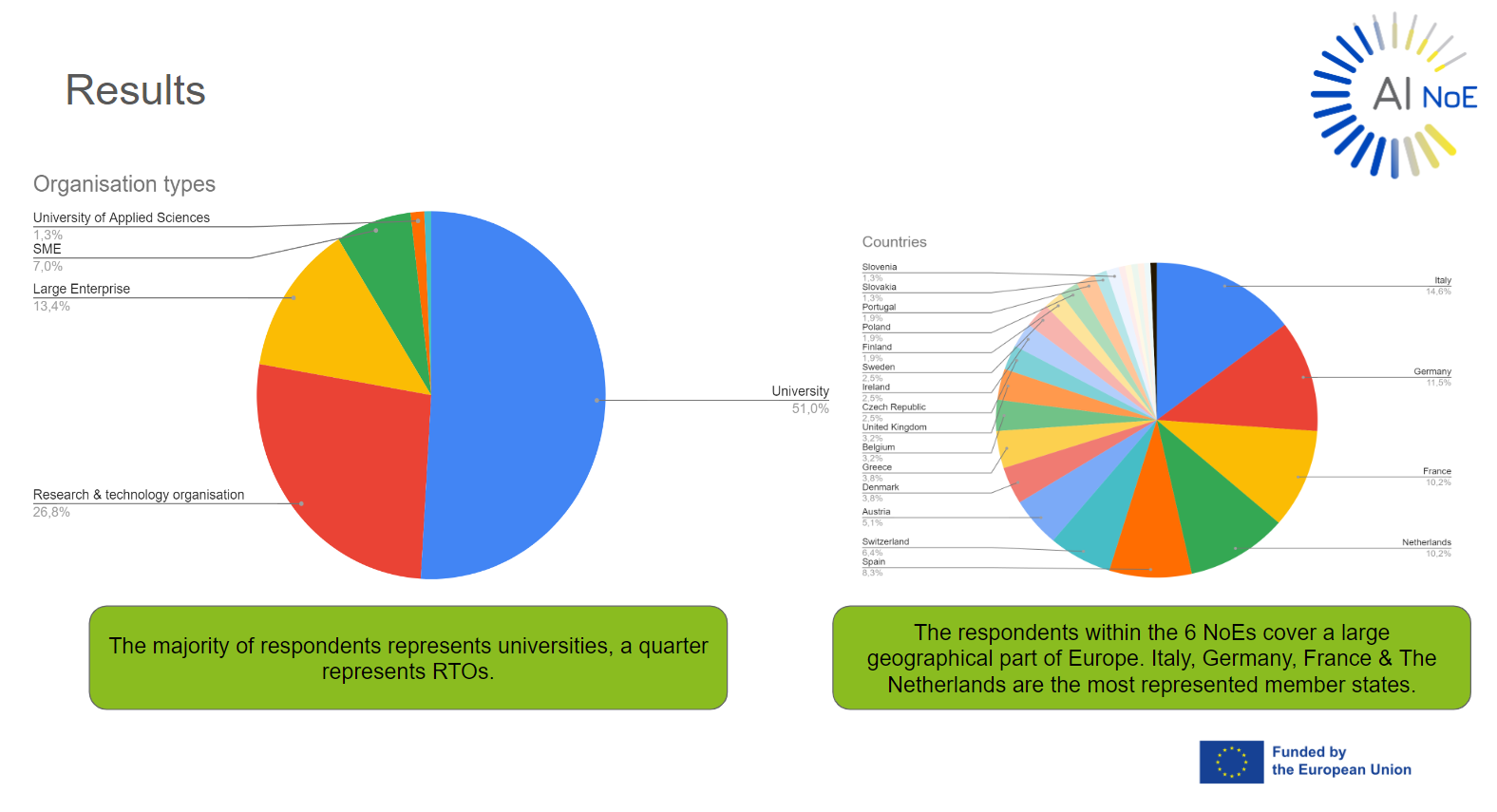
Launch
The first version was launched publicly at the ADRA Forum 2023, 8-9 November 2023 in Versailles, in a plenary session and an in-depth workshop. The workshop Towards a Mapping of the AI-Data-Robotics Ecosystem focused on launching the first European AI ecosystem mapping tool and discussing action to ensure a future-proof and inclusive AI-Data-Robotics ecosystem mapping.The goal of the session was to consider how to move forward. While the current mapping resulted in a large amount of data, it is merely a subset of the entire ADR ecosystem. Moreover, other mapping activities (e.g. DIHs mapping, Adra-e) occur so it is advised to come together and reflect on potential synergies.
During the workshop, moderated by Joachim de Greeff, several speakers preceded the workshop. First, Claudio Lazo (TNO) presented the first Ecosystem Mapping and shared the team’s reflection, lessons learned and recommendations. Then, Anne Bergen (UTwente) presented the cartography activities of Adra-e and lessons for future mapping activities; Gabriel Gonzalez-Castañè (UCC) talked about lessons learned from his experience in making ecosystem mappings for AI4EU; and Cécile Huet reflected on the progress and brought an EC perspective on the goal of the ecosystem mapping. Next was an interactive workshop where participants could move freely across four tables to discuss and brainstorm ‘who will use the mapping’, ‘who should be in the mapping’, ‘what information needs and representation needs. A panel that included Claudio, Anne, Gabriel and Trine Platou (NoE TAILOR) reflected on the results. The outcomes of the workshop, panel and audience discussions shall be used to define next steps.
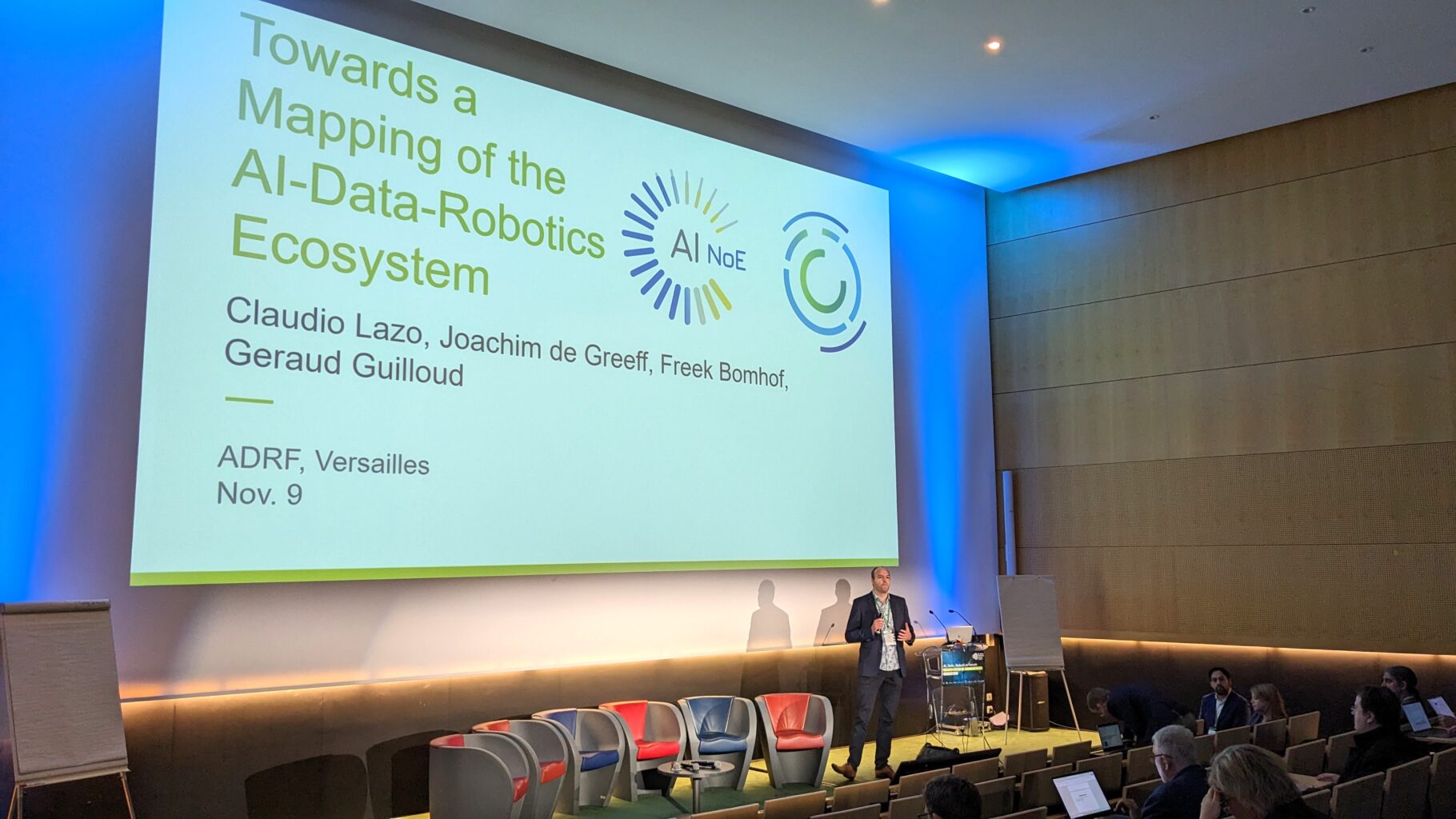
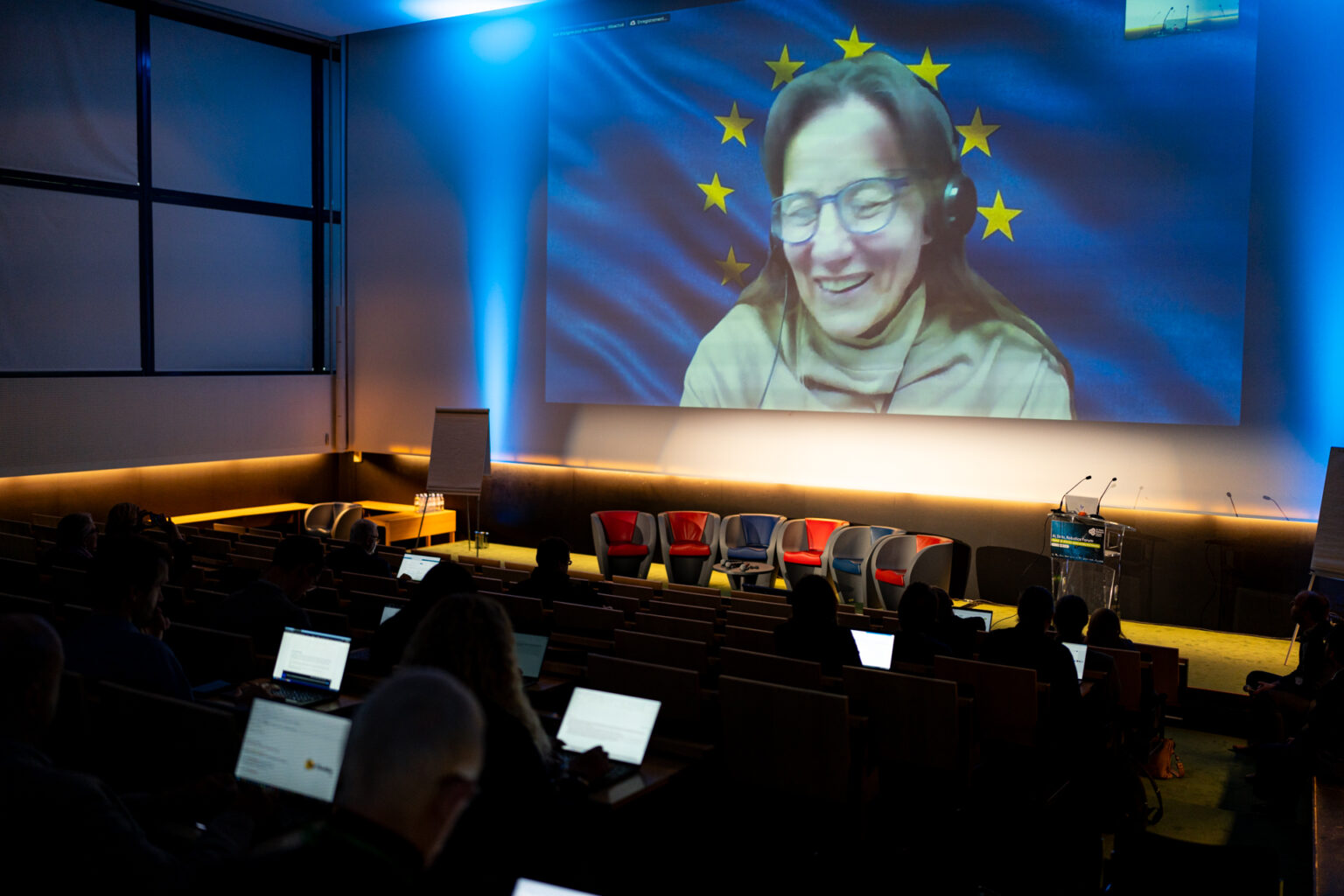
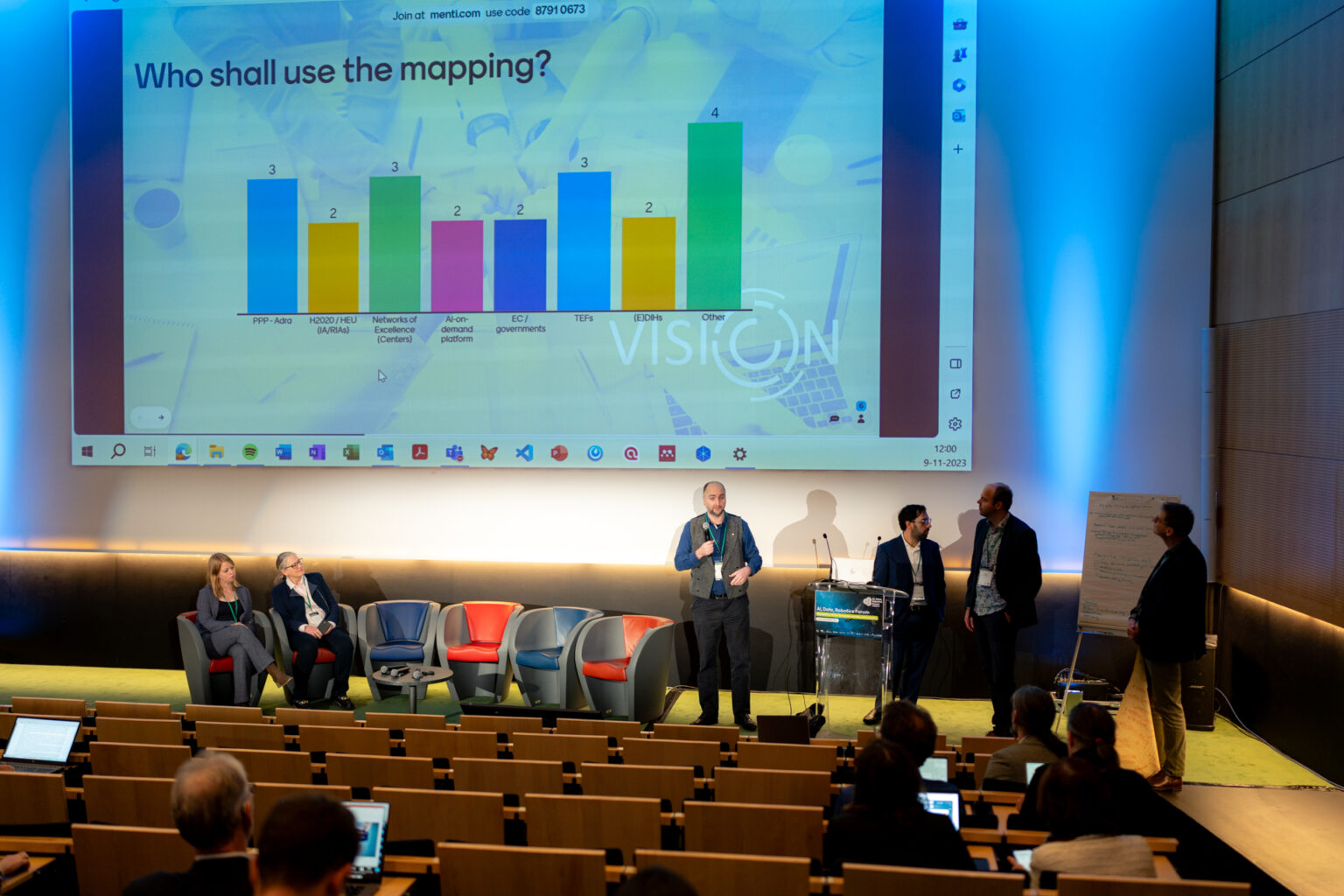
Photo: Benoit Fourrier (Inria)
Team
Working committee lead VISION:
- Claudio Lazo (TNO)
- Joachim de Greeff (TNO)
- Freek Bomhof (TNO)
- Kristina Karanikolova (TNO)
- Géraud Guilloud (TNO)
Working committee NoE representatives:
- Filareti Tsalakanidou (AI4Media)
- Chris Murray (ELISE)
- Lorraine Wolter (ELSA)
- Rebecca Schedl-Warpup (euROBIN)
- George Kampis (HumanE-AI-Net)
- Trine Platou (TAILOR)
Tool development: Erik Boertjes (TNO)
Questions, corrections or comments
For requests to represent your organisation, faculty, group, lab, etc. in this tool: At this stage, this is only possible for organisations in the aforementioned list of NoEs. Please contact your working committee representative.
For general inquiries or requests to alter or remove data of your organisation: Claudio Lazo (email)
